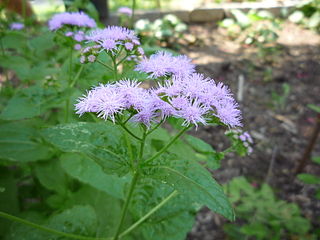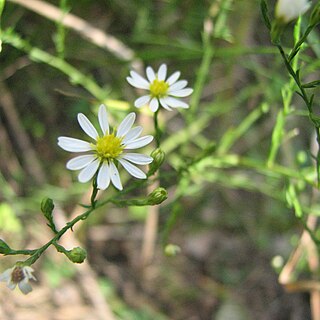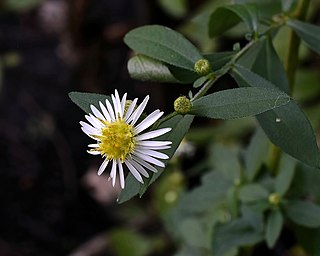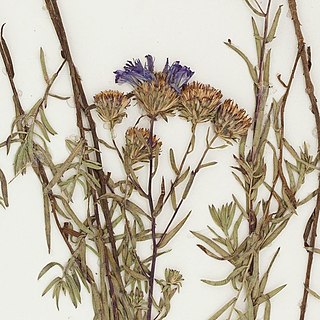External links
| International | |
|---|---|
| National | |
| Academics | |
| Artists | |
| | This article about an American botanist is a stub. You can help Wikipedia by expanding it. |
Guy L. Nesom | |
|---|---|
| Born | August 2, 1945 [1] |
| Nationality | American |
| Alma mater | University of North Carolina Davidson College [2] |
| Scientific career | |
| Fields | Systematic Botany [2] |
| Institutions | University of Texas at Austin [2] |
| Author abbrev. (botany) | G.L.Nesom |
Guy L. Nesom (born August 2, 1945) [1] is an American writer and botanist.
Nesom received his Ph.D. in systematic botany from the University of North Carolina in 1980, and has since contributed much to the fields of botanical nomenclature, systematics, and evolution. His most notable contributions are probably his works on the Asteraceae of North America, with several papers published throughout the 1990s that argued for multiple generic names to replace the single polyphyletic name Aster , [3] and his recent and ongoing contributions to the Flora of North America project. [4]
Several plant species have been named for Nesom, such as Zeltnera nesomii of the gentian family [5] and Steviopsis nesomii of the aster family. [6] Three genera are named in his honor: Nesomia , Neonesomia (a synonym of Medranoa ), and Guynesomia . [7] [8] [9]
The standard author abbreviation G.L.Nesom is used to indicate this person as the author when citing a botanical name. [10]
Harold Ernest Robinson was an American botanist and entomologist.

Ionactis, common name stiff-leaved asters or ankle-asters, is a small genus of plants belonging to the family Asteraceae. These aster-like plants are endemic to North America. One species is widespread across much of the eastern half of the continent, while two others are rare endemics with very restricted ranges.

Liatris, commonly known as gayfeather and blazing star is a genus of flowering plants in the tribe Eupatorieae within the family Asteraceae native to North America. Some species are used as ornamental plants, sometimes in flower bouquets. They are perennials, surviving the winter and resprouting underground corms.

Symphyotrichum is a genus of over 100 species and naturally occurring hybrids of herbaceous annual and perennial plants in the composite family, Asteraceae, most which were formerly treated within the genus Aster. The majority are endemic to North America, but several also occur in the West Indies, Central and South America, as well as one species in eastern Eurasia. Several species have been introduced to Europe as garden specimens, most notably New England aster and New York aster.

Conoclinium, the mistflowers, is a genus of four species of herbaceous perennial flowering plants, native to North America. They are 0.5 to 2 metres tall, and have blue to purple or violet flowers.

Ageratina herbacea is a North American species of flowering plants in the family Asteraceae known by the common names fragrant snakeroot and Apache snakeroot. It is native to desert regions of the southwestern United States and northern Mexico. It grows in rocky slopes in conifer forests and woodlands.

Ageratina havanensis, the Havana snakeroot or white mistflower, is a species of flowering shrub in the family Asteraceae, native to the south-western United States (Texas), Cuba, and north-eastern and east-central Mexico. Unlike many other species of Ageratina, it is evergreen.

Canadanthus is a North American monotypic genus of flowering plants in the family Asteraceae. The only species is Canadanthus modestus, commonly known as great northern aster or western bog aster. It is native to most of Canada and to northern parts of the United States.
Brickelliastrum is a North American genus of flowering plants in the tribe Eupatorieae within the family Asteraceae. Its species are native to Arizona, New Mexico, and Texas in the United States and to northern Mexico.
Nesomia is a genus of flowering plants in the tribe Eupatorieae within the family Asteraceae.

Symphyotrichum depauperatum, commonly known as serpentine aster or starved aster, is a rare species in the family Asteraceae adapted to serpentine barrens, an ecosystem with a high concentration of toxic metals in the soil. It has been found in Pennsylvania, Maryland, and on some diabase glades in North Carolina. It grows to 50 centimeters and has white ray florets surrounding a center of yellow disk florets.
Ageratina paupercula, called the Santa Rita snakeroot, is a North American species of shrubs or perennial herbs in the family Asteraceae. It is found only in the states of Arizona, Sonora, Chihuahua, Durango, Nayarit, and Jalisco.
Ageratina thyrsiflora is a North American species of plants in the family Asteraceae. It is native mostly to northwestern Mexico. The range extends just barely into the United States, a single herbarium specimen having been collected in 1929 just north of the border town of Nogales, Arizona.
Asanthus thyrsiflorus is a Mexican species of plants in the family Asteraceae. It is native to the states of San Luis Potosí, Chihuahua, Zacatecas, Aguascalientes, Jalisco, Coahuila, and Durango in north-central Mexico.
Brickelliastrum nesomii, synonym Steviopsis nesomii, is a species of Mexican plants in the family Asteraceae. It has been found only in the states of Nuevo León and Tamaulipas in northeastern Mexico.
Conoclinium betonicifolium, the betony-leaf mistflower or betonyleaf thoroughwort, is a North American species of flowering plants in the family Asteraceae. It is widespread across much of Mexico from Chihuahua to Quintana Roo, and has also been found in Texas and Guatemala.
Conoclinium dissectum, the palm-leaf mistflower or palmleaf thoroughwort, is a North American species of flowering plants in the family Asteraceae. It is native to northern Mexico and the southwestern United States.

Symphyotrichum ontarionis is a species of flowering plant in the family Asteraceae native to eastern North America. Commonly known as Ontario aster and bottomland aster, it is a perennial, herbaceous plant that may reach heights of 120 centimeters. Each flower head has many tiny florets put together into what appear as one.

Symphyotrichum turneri is a species of flowering plant in the family Asteraceae native to Durango, Mexico.